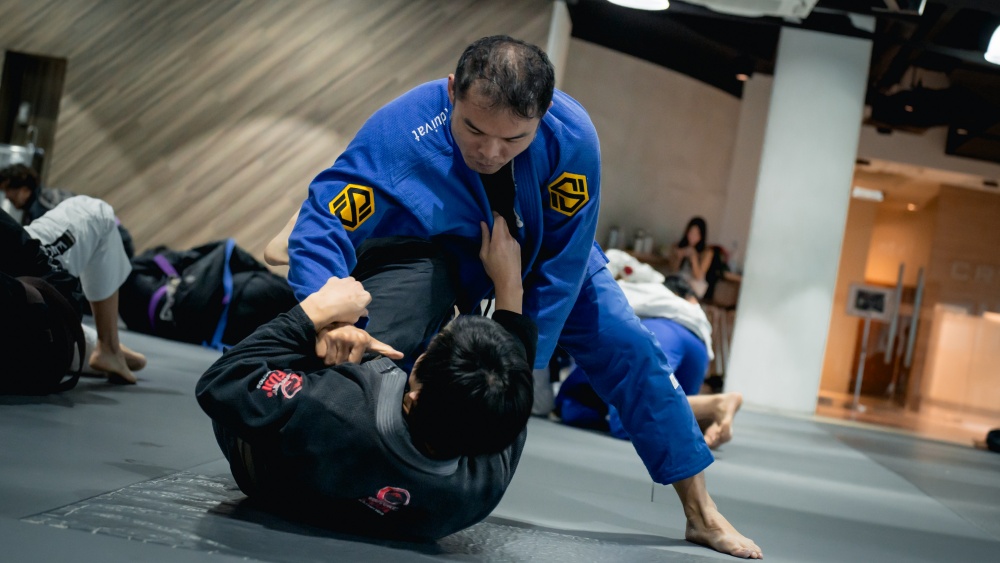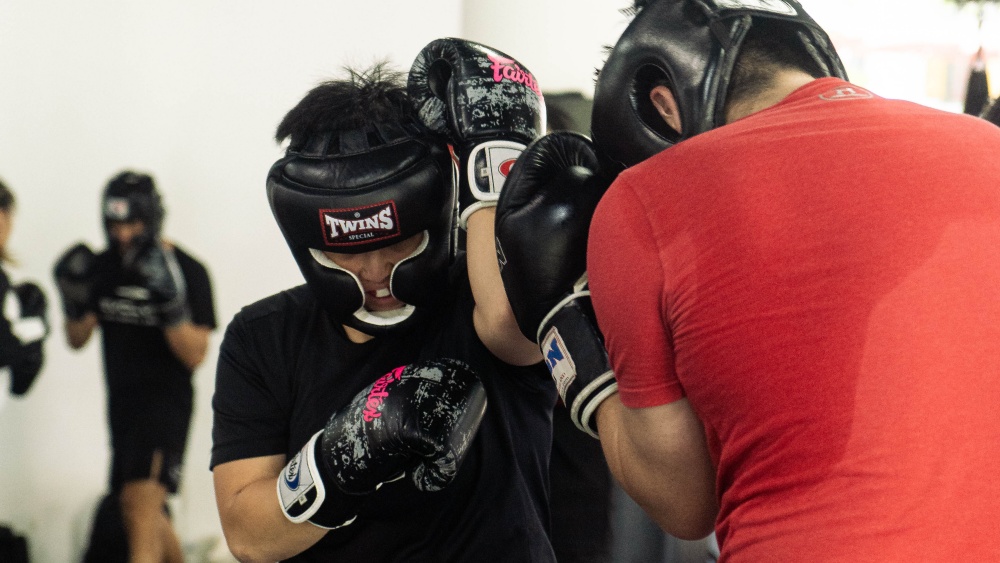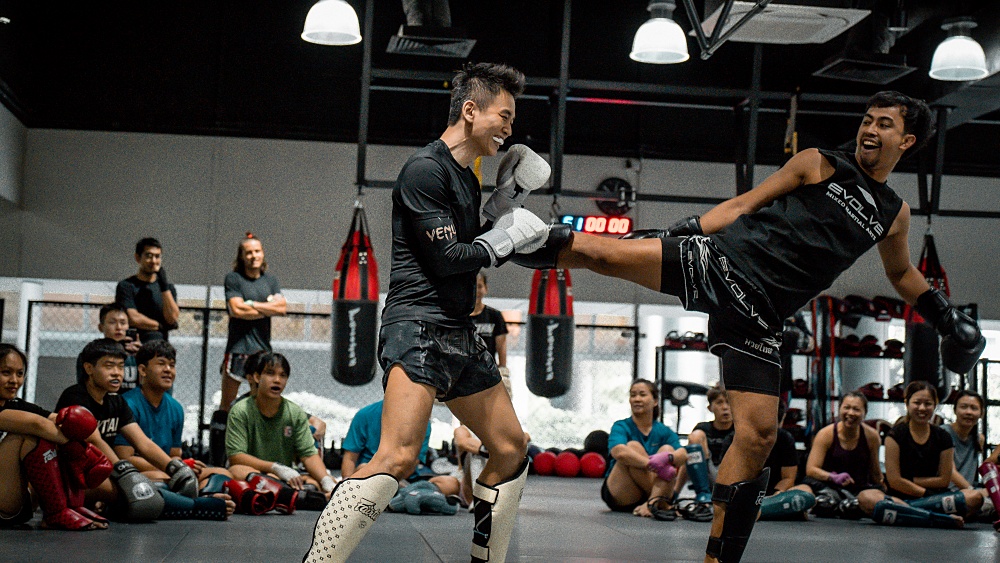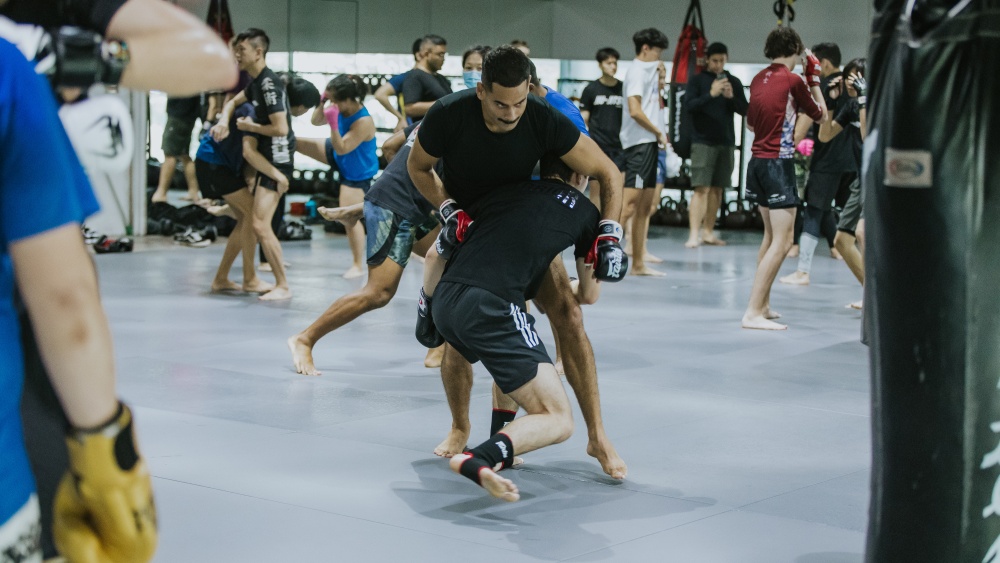In martial arts, you’ll often come across a wide range of terms used during training. But when you hear the word sparring, what comes to mind? It means stepping into the training space with another person to apply your skills in a realistic setting. But how sparring works varies greatly between disciplines like BJJ, Boxing, Muay Thai, and MMA. Each style uses it to build skill, fitness, and mental agility without focusing on harm or fear.
Many beginners might think sparring is intimidating, but it is often the opposite. Sparring is fun, controlled, and safe, especially in a setting where it is guided by coaches and done with training partners who are there to learn alongside you. That being said, let’s dive into how sparring works in each art and why it matters.
1) BJJ (Brazilian Jiu Jitsu)

In BJJ, “rolling” is live sparring where you apply techniques like passes, escapes, and submissions in real-time, sharpening your timing, awareness, and problem-solving under pressure.
In BJJ, sparring is also often referred to as ‘rolling‘. It is a dynamic and controlled way to practice techniques on the ground. Rounds usually begin from either a standing or seated position, depending on the focus of the class. The goal is to apply what was taught during the lesson, working with your partner to improve positioning, stay balanced, and look for opportunities to use submissions like armbars or chokes. Rolling usually lasts between five to seven minutes and often ends when one person secures a dominant position or a tap occurs, signaling that the round is over.
Rolling helps improve problem-solving, timing, and positional awareness. Coaches may guide students to focus on specific positions, such as practising escapes from the bottom mount or guard passes. This live drilling teaches students to stay calm under pressure and react smoothly, much like playing chess with their bodies.
2) Boxing

Boxing sparring focuses on timing, footwork, and rhythm, using light contact to practice technique, movement, and combinations in short, controlled rounds.
Boxing sparring is all about timing, footwork, and precision. As much as many believe it is the punches that define boxing, it is often the movements and rhythm that shape the outcome. Partners usually wear gloves, headgear, and mouth guards during sparring. The focus is on combining techniques and building awareness, not just going head-to-head. You’ll hear coaches call combinations like one-two-three as you move, dodge, and shift your weight.
Sparring in boxing can typically last between two to three minutes per round. Students usually practice light contact to mimic punches, focusing on movement and timing. The round often ends when the time is up, allowing both partners to reset and reflect before the next round begins.
3) Muay Thai

Muay Thai sparring blends kicks, knees, clinch, and punches in light, controlled rounds focused on timing, balance, and playful, technical exchanges.
Muay Thai sparring includes kicks, knees, and clinch work along with punches. More often than not, sparring is done with a light and controlled pace. It can even feel playful at times, as partners tease and challenge each other to keep the rounds engaging and enjoyable.
The goal is to develop a sense of timing and range with each strike. Protective gear like headgear, mouth guards, and shin guards allows students to practice with control while still building power and flow. This creates a safe and focused environment where you can work on rhythm, distance, and coordination across all areas of striking.
Each sparring round in Muay Thai usually lasts between two to five minutes, with students focusing on timing, balance, and controlled exchanges. The emphasis is on fluid movement, clean technique, and reading your partner rather than overpowering them.
4) MMA

MMA sparring mixes striking, grappling, and transitions in varied rounds that build adaptability, fight IQ, and composure under pressure.
MMA sparring blends both striking and grappling. Some rounds mimic Boxing or Muay Thai, while others move into takedowns, ground transitions, and submissions. It’s unpredictable, just like a real fight.
Because MMA includes different skills, the sparring rounds vary in focus each session. One round may be stand-up only, another may be a mix, and then another focuses on wrestling transitions. This variation develops adaptability, cardio under pressure, and the ability to read and react, no matter where the fight goes.
How They Complement Each Other
MMA practitioners often cross-train in striking arts to sharpen stand-up skills. Boxing brings refined punching and footwork, while Muay Thai covers clinch and knee range. BJJ pairs grappling finesse with these striking arts to create well-rounded fighters.
Cross-training offers both physical variety and mental stimulation. Each discipline improves a different part of your game. A hit‑and‑move boxer learns to defend takedowns, while a grappler builds striking awareness, timing, and footwork. Together, they form a more complete fighter.
Sparring Tips For Beginners
If you are new to sparring, take it slow. Start with light intensity and focus on control and technique. The goal is to apply what you have learned, not to win or prove anything. If you are training in a striking art like boxing or Muay Thai, use sparring to work on your timing, distance, and movement.
For grappling arts like BJJ, rolling is a great way to practice transitions and maintain good positioning. Pay attention to balance and breathing, and always aim to move with purpose. If you enjoy a mix of both striking and grappling, MMA sparring will help you develop adaptability and flow between different situations. Focus on staying calm and making thoughtful decisions.
Stay relaxed and treat it as a chance to improve your rhythm and awareness. Chances are, every advanced student is simply working on refining their techniques. Going too hard does not prove anything. It usually shows a lack of control and understanding rather than skill, and often exposes your habits or weaknesses more than it hides them.
Conclusion
Sparring across BJJ, Boxing, Muay Thai, and MMA shares one central purpose: training live, staying sharp, and learning in a supportive environment. Each discipline brings its own focus, be it ground control, striking precision, striking variety, or full-spectrum adaptability. These elements build physical coordination and sharpen mental clarity.
Through smart sparring practices, you move beyond machines and routines. You build instincts, confidence, and real skill. That’s the power behind martial arts training: learning to move, think, and adapt while growing with others who share your journey.
You may also like:
The Science Of Footwork: Why Movement Matters In Every Martial Art
Alright, let’s get this out of the way first: yes, Jake Paul is officially ranked by the WBC. And yes, depending on who you ask, that either means boxing is finally evolving, or that it’s…
If you are thinking about picking up a striking martial art in Singapore, you’ve probably heard of two popular options, Muay Thai and Boxing. Whether your goal is fitness, fun, or personal growth, understanding the…
Whether you are training at a local martial arts gym in Singapore training Boxing, Muay Thai, MMA or anywhere else, you will always hear one word repeated, footwork. Why is that? Well, you can have…
It usually starts as a joke. You’re in boxing class, working the pads, and the coach calls out, “Alright, switch stance!” You awkwardly shift your right foot forward. You feel like a baby deer. Nothing…
Tennis balls aren’t just for tennis players. They’re also a valuable tool for boxers looking to enhance their agility, coordination, and reflexes. Incorporating tennis ball drills into your boxing training regimen can significantly improve your…
High-intensity interval training (HIIT) alternates all-out efforts with brief rest or low-intensity periods. Unlike steady-state cardio, HIIT exercises, martial arts such as Muay Thai, and some aspects of BJJ, pushes you into anaerobic zones. Think…
There’s a saying in grappling circles: “Whoever gets the underhook, gets the win.” It might sound dramatic, but spend enough time rolling, and you’ll start to realize it’s not far off. The underhook is one…
In 2009, at the IBJJF World Championship, a relatively unknown BJJ black belt named Bernardo Faria faced a physically superior opponent in the open weight division. As the match intensified, Faria slid underneath his opponent,…
Think martial arts is a young person’s game? Think again. Signing up for martial arts classes could be one of the best decisions you’ve ever made for your mental and physical health, whether you’re 40,…
Trying something new without knowing what to expect can feel intimidating. Whether it’s a new job, a change in routine, or something completely different like learning a martial art. Out of all the styles available,…
When people think of MMA, they usually picture the highlight moments, explosive knockouts, slick submissions, and last-minute comebacks. What they don’t see is the hard work and engine underneath all of it: conditioning. Conditioning is…
Not many Muay Thai fighters compete at the highest level well into their late 30s. Even fewer manage to stay on the edge. Nong-O Hama is one of the rare exceptions. Since making his debut…



![[WATCH] IND vs SA 2025: Rishabh Pant vents frustration at Kuldeep Yadav for slow over-rate warning](https://lbsports88.com/wp-content/uploads/2025/11/watch-ind-vs-sa-2025-rishabh-pant-vents-frustration-at-kuldeep-yadav-for-slow-over-rate-warning-360x180.jpg)






























![[WATCH] IND vs SA 2025: Rishabh Pant vents frustration at Kuldeep Yadav for slow over-rate warning](https://lbsports88.com/wp-content/uploads/2025/11/watch-ind-vs-sa-2025-rishabh-pant-vents-frustration-at-kuldeep-yadav-for-slow-over-rate-warning-120x86.jpg)